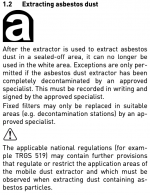So I'm looking at doing some scraping of paint on an exterior which likely has lead (I haven't tested yet). Only looking to remove loose stuff, not do a total strip.
I have one of those vacuum friendly scrapers where the handle is hollow and can be hooked up to a vac. As I have read, these are approved for dry scraping lead based paint.
I have a Fein Turbo w/ a hepa filter which I also use for sanding and drilling dust collection. I usually do general cleanup w/ a rigid vac that has an aftermarket filter.
My plan was to use the Fein vac w/ the vacuum scraper to take off the loose paint and control the dust. But one thing that I get a little mixed up by is this: if I use the vac for lead, is it now considered 'contaminated' and should be dedicated to that? Or is it sufficient to keep the filter in, dispose of the bag, and clean the vac off?
Same question would apply, I guess, to a festool sander. Is it considered 'lead only' if used for lead paint? Or does it just need to be cleaned?
I have one of those vacuum friendly scrapers where the handle is hollow and can be hooked up to a vac. As I have read, these are approved for dry scraping lead based paint.
I have a Fein Turbo w/ a hepa filter which I also use for sanding and drilling dust collection. I usually do general cleanup w/ a rigid vac that has an aftermarket filter.
My plan was to use the Fein vac w/ the vacuum scraper to take off the loose paint and control the dust. But one thing that I get a little mixed up by is this: if I use the vac for lead, is it now considered 'contaminated' and should be dedicated to that? Or is it sufficient to keep the filter in, dispose of the bag, and clean the vac off?
Same question would apply, I guess, to a festool sander. Is it considered 'lead only' if used for lead paint? Or does it just need to be cleaned?

